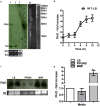Quorum sensing in Pseudomonas aeruginosa mediated by RhlR is regulated by a small RNA PhrD
- PMID: 30674910
- PMCID: PMC6344545
- DOI: 10.1038/s41598-018-36488-9
Quorum sensing in Pseudomonas aeruginosa mediated by RhlR is regulated by a small RNA PhrD
Abstract
Pseudomonas aeruginosa is a highly invasive human pathogen in spite of the absence of classical host specific virulence factors. Virulence factors regulated by quorum sensing (QS) in P. aeruginosa cause acute infections to shift to chronic diseases. Several small regulatory RNAs (sRNAs) mediate fine-tuning of bacterial responses to environmental signals and regulate quorum sensing. In this study, we show that the quorum sensing regulator RhlR is positively influenced upon over expression of the Hfq dependent small RNA PhrD in Pseudomonas. RhlR transcripts starting from two of the four different promoters have same sequence predicted to base pair with PhrD. Over expression of PhrD increased RhlR transcript levels and production of the biosurfactant rhamnolipid and the redox active pyocyanin pigment. A rhlR::lacZ translational fusion from one of the four promoters showed 2.5-fold higher expression and, a 9-fold increase in overall rhlR transcription was seen in the wild type when compared to the isogenic phrD disruption mutant. Expression, in an E. coli host background, of a rhlR::lacZ fusion in comparison to a construct that harboured a scrambled interaction region resulted in a 10-fold increase under phrD over expression. The interaction of RhlR-5'UTR with PhrD in E. coli indicated that this regulation could function without the involvement of any Pseudomonas specific proteins. Overall, this study demonstrates that PhrD has a positive effect on RhlR and its associated physiology in P. aeruginosa.
Conflict of interest statement
The authors declare no competing interests.
Figures









References
Publication types
MeSH terms
Substances
LinkOut - more resources
Full Text Sources

